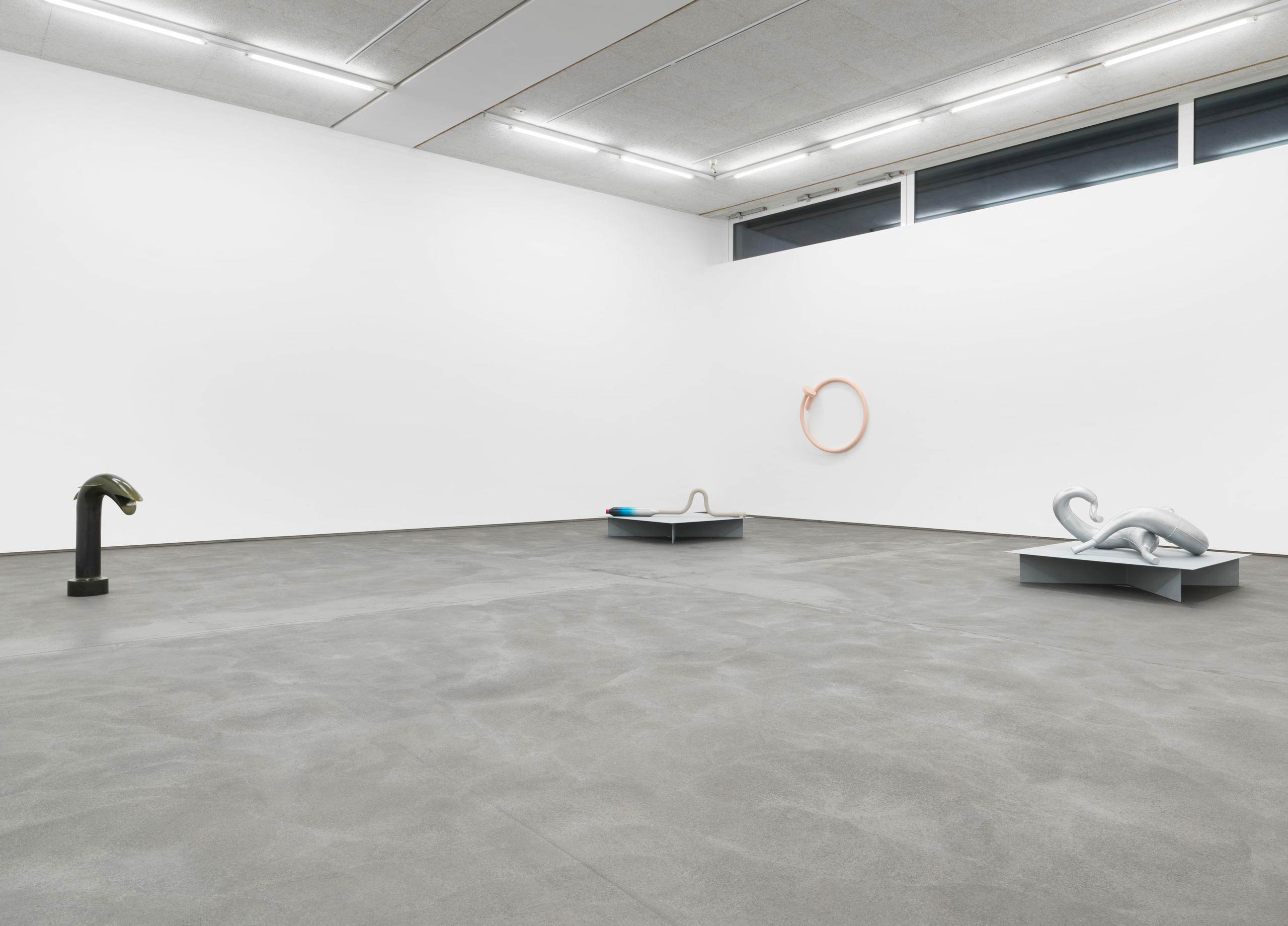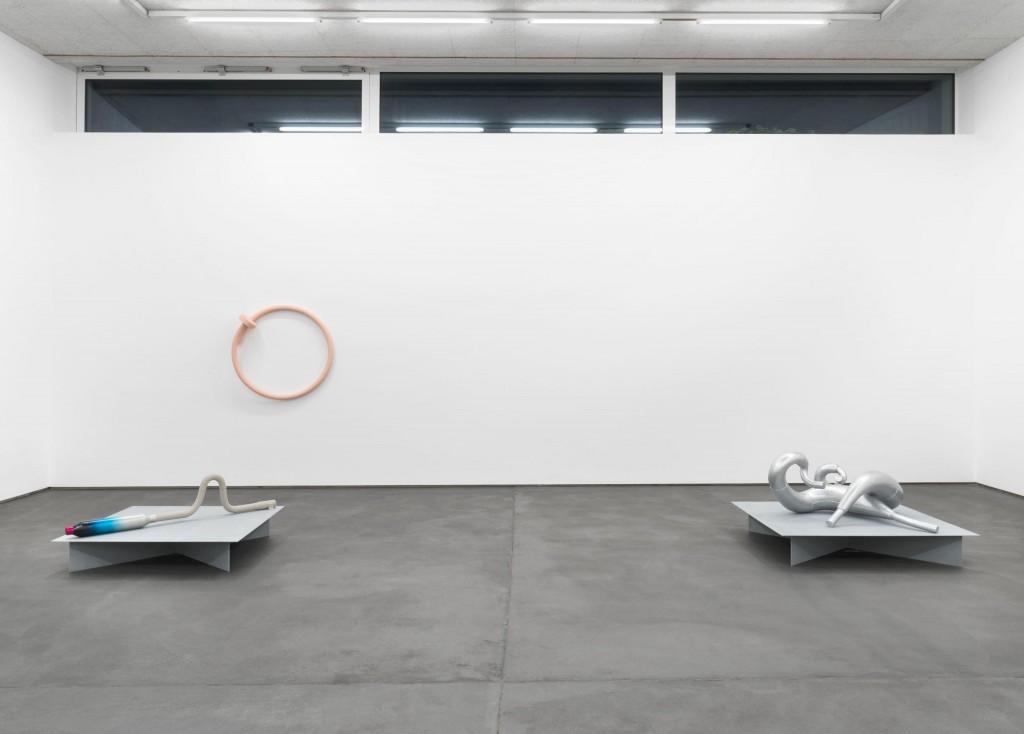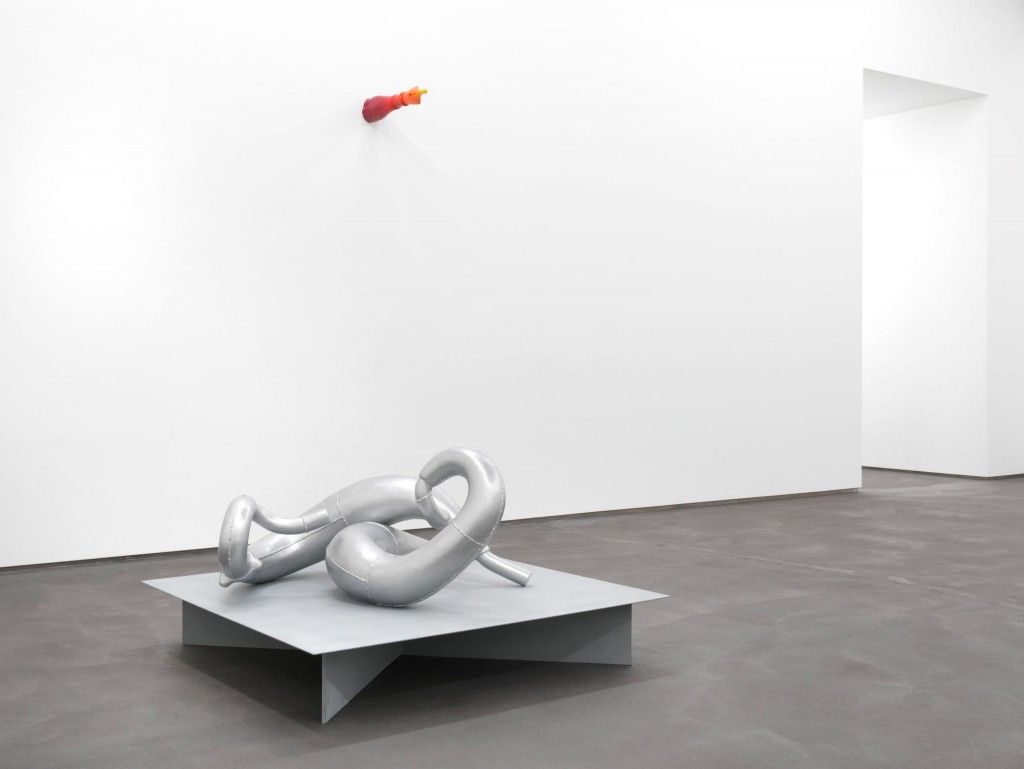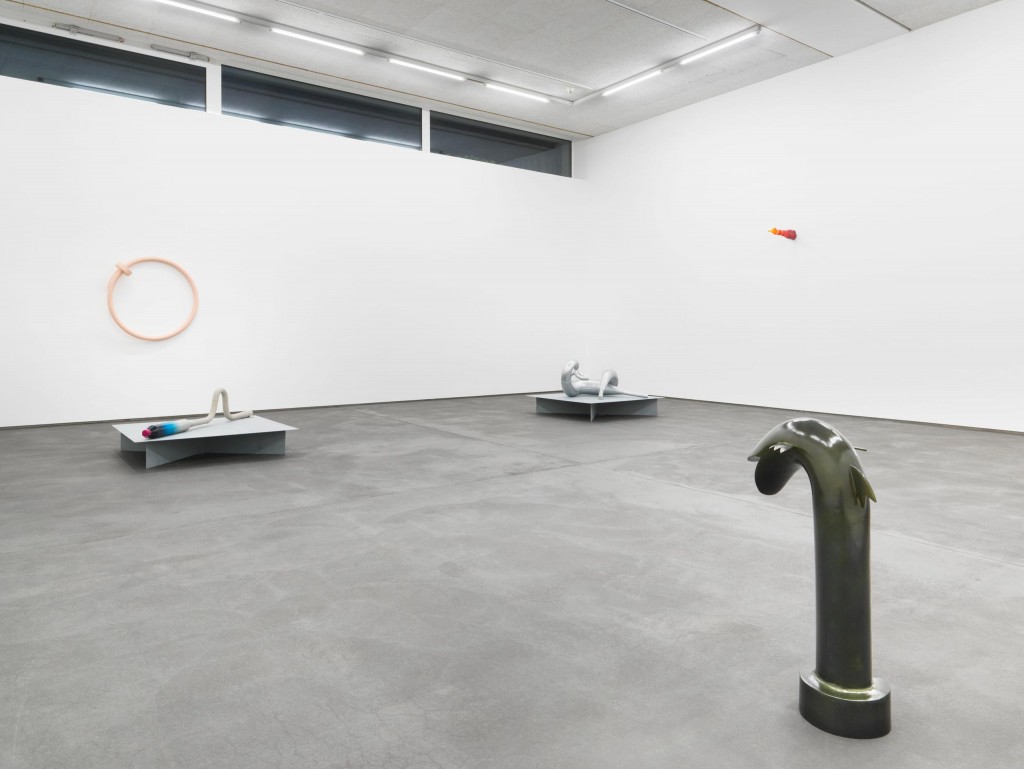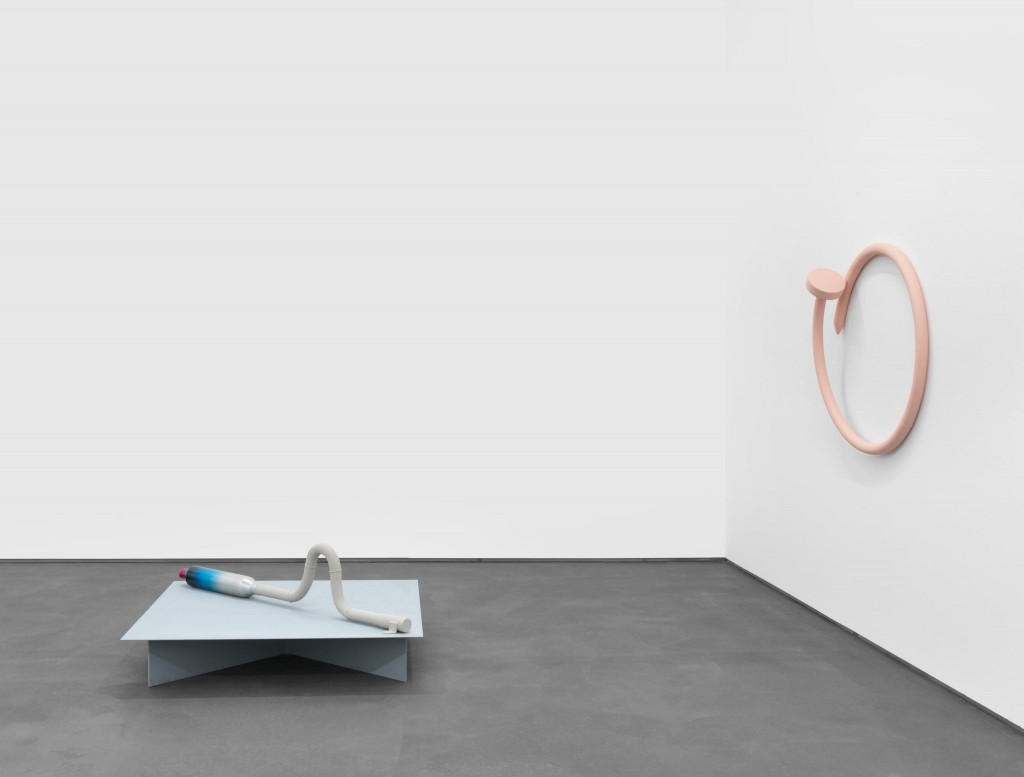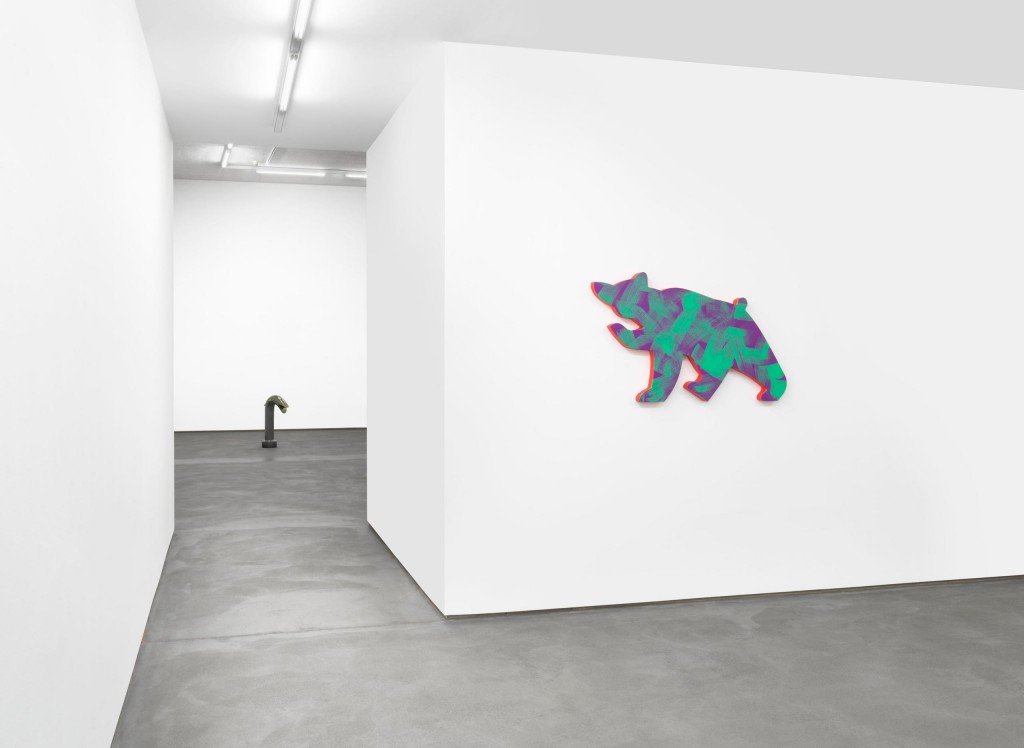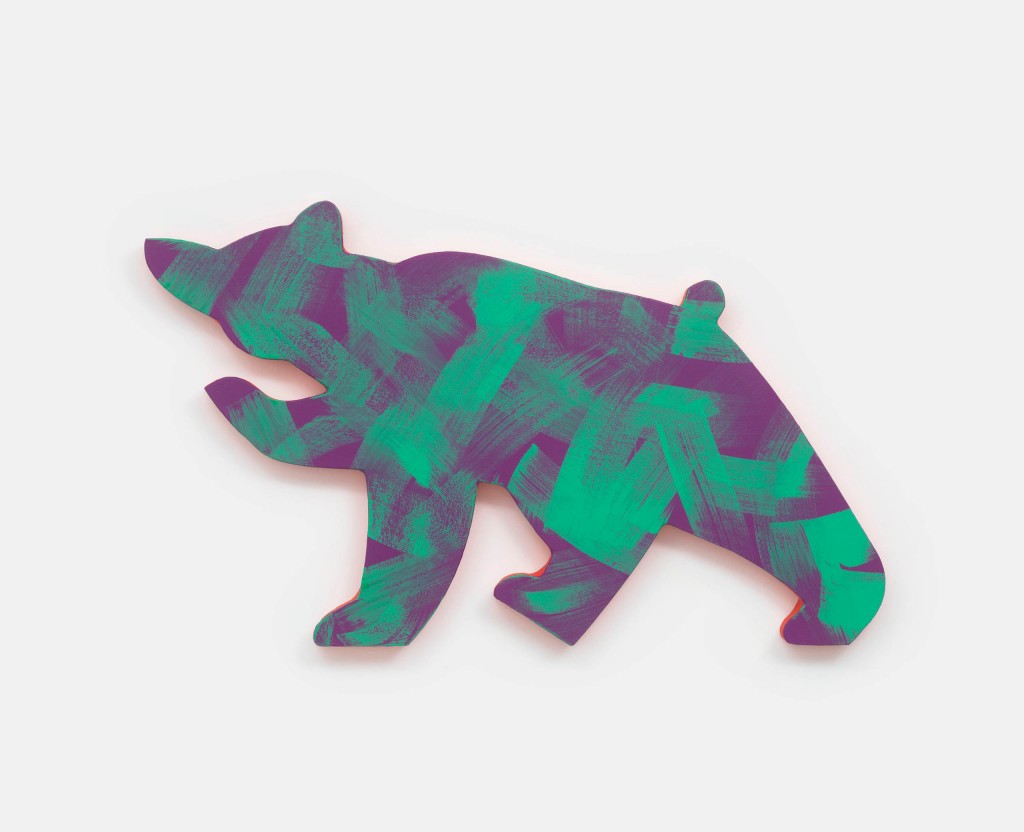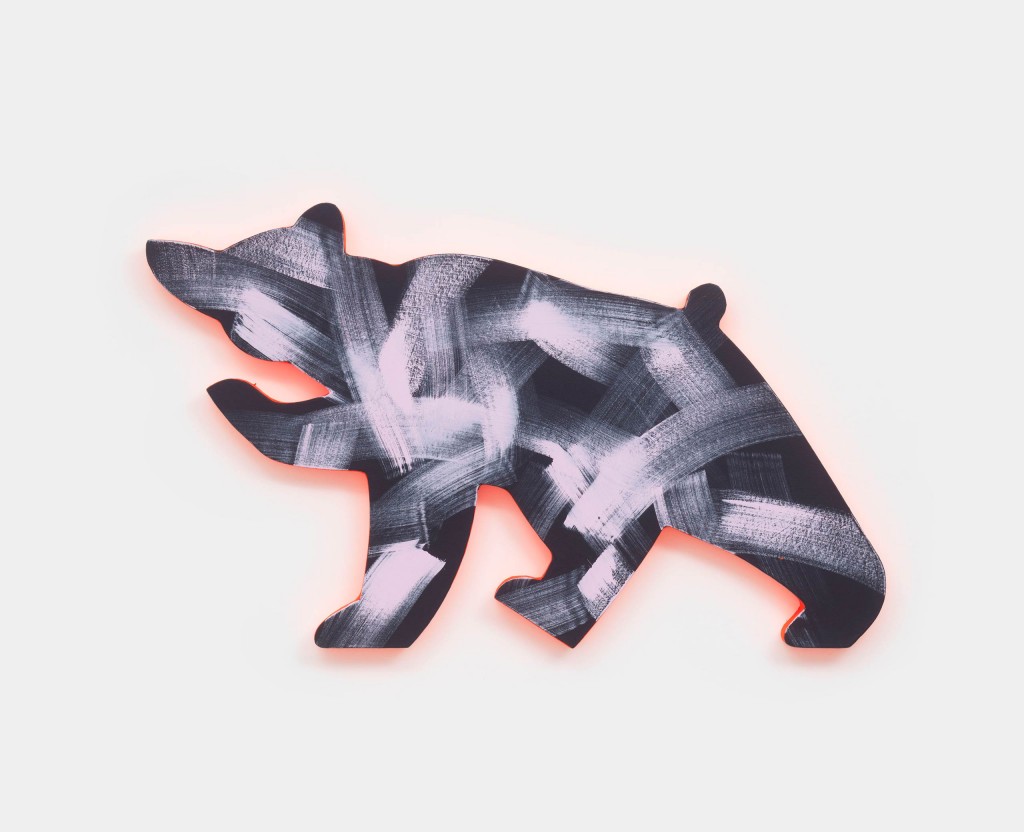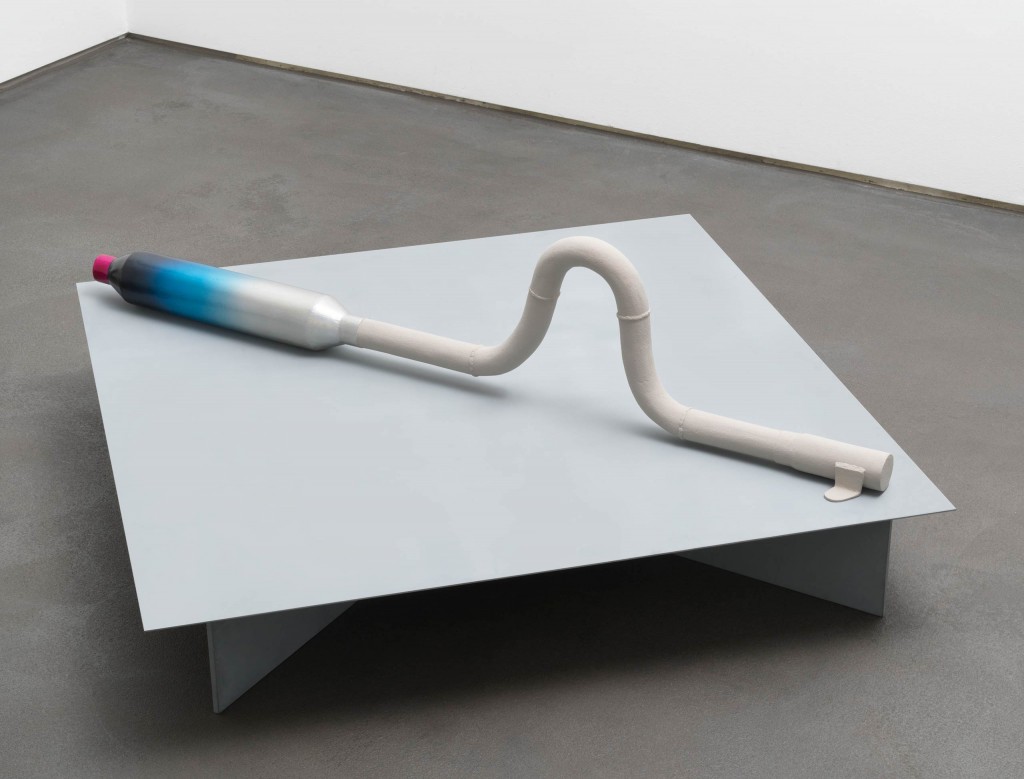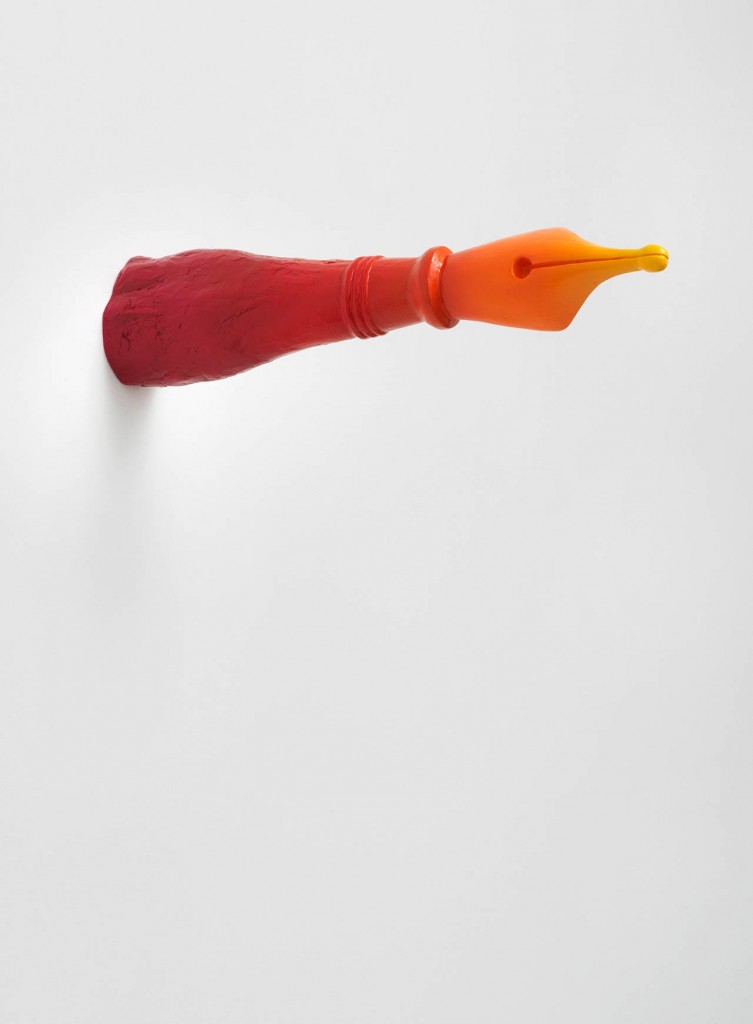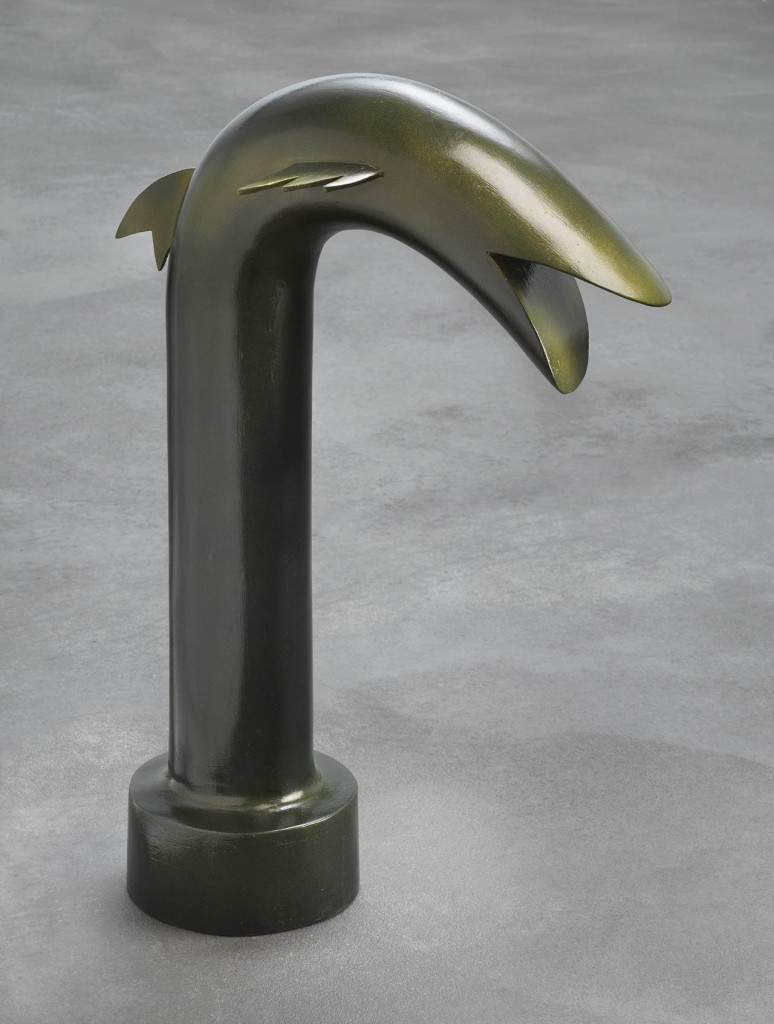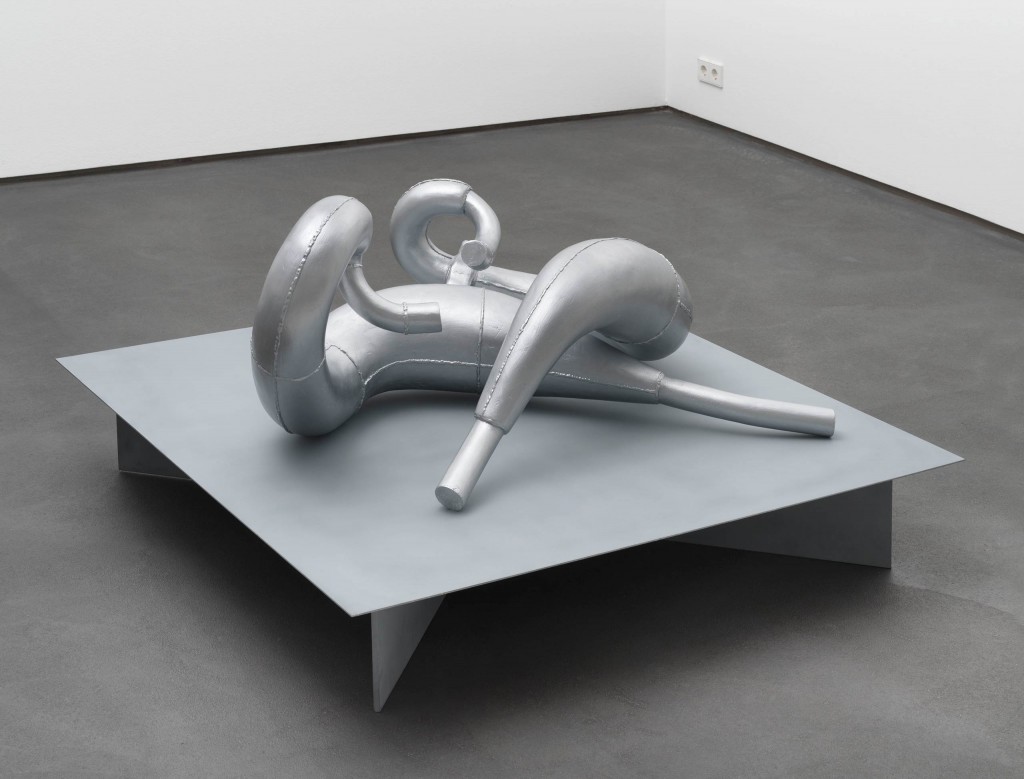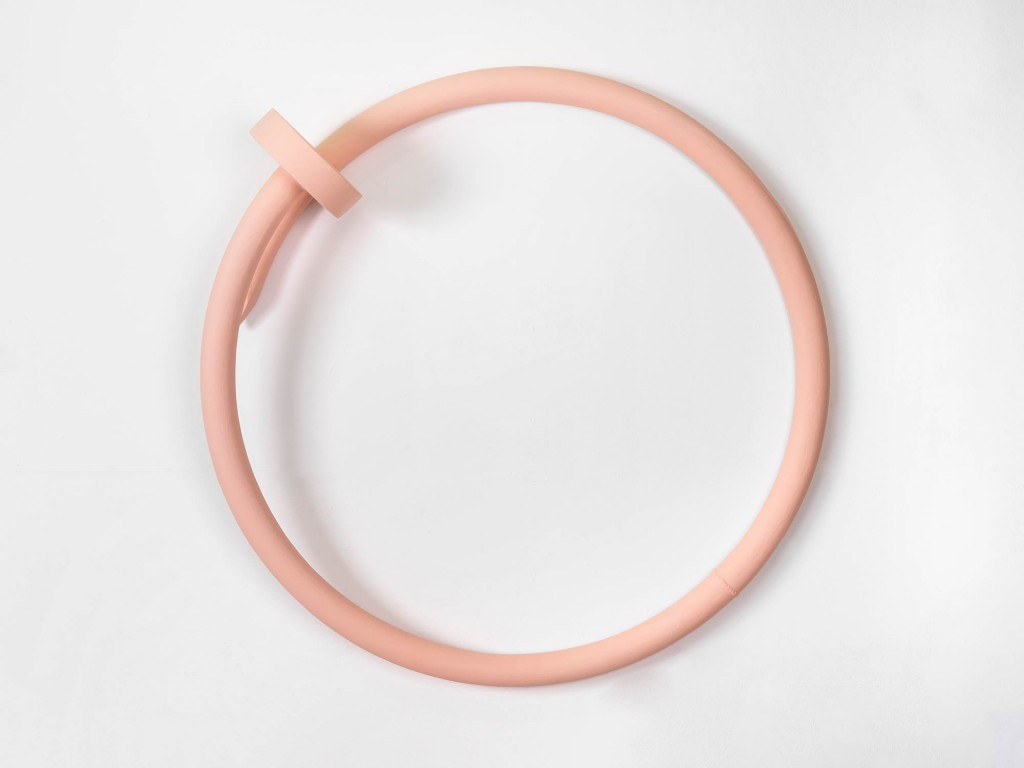DITTRICH & SCHLECHTRIEM is proud to present AZURE, the first solo show in Berlin by Italian artist ALFREDO ACETO (b. Turin, IT, 1991 / lives and works in Lausanne, CH). Aceto continues his interest in creating hybrid spaces populated with objects engaging in a symbolic dialogue concerning sculpture and narrative. For Azure, Aceto has created a new cast of objects—referring in form to automobile parts, jewelry, logos, a gutter-hydrant or an arm with a pen—all precisely positioned within the gallery space directly on the floor, on shallow pedestals, hung on the wall or protruding into the room. The environment emulates classical museum-like arrangements while the objects themselves remain as fantastic approximations of the originals, either oversaturated in color, uniform in surface texture, or diminished in detail, recalling an almost digital world.
“Alfredo Aceto works at the frontiers of the vectors used to define a thing and an identity. Interested in the nature of the object, he explores its attributes in order to re-conceive it in some new form that expands its narrative possibilities.
Azure is a convertible designed by the automobile-maker Bentley to offer drivers and their passengers a panoramic ride. Evoking the colors and atmosphere of the French Riviera (the “Costa Azzurra” or “Sky-blue Coast” in Italian), the prestigious vehicle was conceived to enhance the visual experience while driving along the coast, following the imaginary lines of the horizon and the road. The flowing lines of the auto’s body develop in the direction of the sea and the land’s promontories. Azure is itself a horizon, its folding roof allows it to merge with the coastline, on the border between the fragrance and sensations of a color and the hues of an authentic landscape.
In the same way, the mufflers (Echinoidea, 2018, and Olive Sea Snake Digesting a Watermelon, 2018) imitate with their surfaces the intriguing nature of an automobile’s body of whose ecosystem they alter only an extremely technical role. Through this parody of their status, the sculptures acquire the liberty of a character capable of transforming his inadequacies into a new narrative structure. In Juste un Clou Rose (2018), Aceto considers the shape of an object with strong connotations, in this instance a Maison Cartier ring, by modifying its color and size in order to reach a formal neutrality that is stripped of any evident aesthetic allusions to the jewelry industry. Through this procedure of eliminating details, the object in the sculpture discovers itself to be a new entity, liberated from what usually defines it and limits it to one single productive, historical, and geographical context. The shape of a nail bent over onto itself can become an amulet for another culture. A muffler can transform into the image of a snake digesting a watermelon.
In a constellation of timid, inept objects, Gutter-Hydrant (2018), a hybrid gutter/fire hydrant with the features of some underwater creature, and Pen with an Arm (2018), an arm/fountain pen that serves as a street sign, were conceived by Aceto as index hands that guide the viewer’s gaze. Composed of double and even triple identities, these works work as “chimeras” that despite being clumsy and grotesque are capable of triggering an anti-narration and alternative model of using space, of observing and understanding works.”
The above is an excerpt from Alfredo Aceto and the Anti-Heroic Object, an essay contributed by Caterina Molteni, published in the exhibition catalogue available in the gallery in December 2018. For further information on the artist and the works or to request images please contact Owen Clements, owen@dittrich-schlechtriem.com
Alfredo Aceto is currently a professor at the ECAL, Switzerland, where he completed his studies in 2014. He attended MSA^, The Mountain School of Art in Los Angeles, USA in 2016.
Aceto has exhibited internationally in Paris, Copenhagen, Rome, Brussels and Switzerland. He will have a solo show at the Instituto Svizzero, Milan, opening in February 2019. In 2018, Aceto was nominated for the Swiss Art Awards, Basel. His work was previously included in our 2017 group show AS IF WE NEVER SAID GOODBYE, Berlin.
DITTRICH & SCHLECHTRIEM freuen sich, mit AZURE die erste Einzelausstellung des italienischen Künstlers ALFREDO ACETO (geb. 1991, Turin, IT / lebt und arbeitet in Lausanne, CH) in Berlin zu zeigen. In der Schau entwickelt Aceto seinen Versuch weiter, hybride Räume zu schaffen, in denen er Objekte in einem symbolischen Dialog über Fragen der Skulptur und Erzählformen inszeniert. Für Azure hat Aceto eine neue Gruppe von Objekten kreiert, deren Form sich von Autoteilen, Schmuck, Logos, einem Hydranten oder einem Arm mit einem Füllfederhalter herleitet. Auf den Boden gestellt, auf niedrigen Sockeln, an der Wand hängend oder in den Raum hineinragend bilden sie eine genau austarierte Konstellation in der Galerie, die klassische Museumspräsentationen nachahmt, während die Objekte selbst fantastische Annäherungen an die Originale darstellen. In ihrer übersättigten Farbgebung, homogenen Oberflächenstruktur und formalen Reduktion erinnern sie an eine beinahe digitale Welt.
„Alfredo Aceto stellt Vektoren, die ein Ding und eine Identität bestimmen, auf die Probe. Sein Interesse am Wesen des Objekts lässt ihn seine Eigenschaften erkunden, um es dann neu zu denken, ihm eine Form zu geben, die seine narrativen Potenziale erweitert.
Der Azure ist ein Cabrio der Automarke Bentley, das dem Fahrer und seinen Beifahrern ein Panoramaerlebnis bieten soll. Ziel bei der Gestaltung des Luxusautomobils, dessen Name an die Farben und Atmosphäre der französischen Riviera (auf Italienisch „Costa Azzurra“ oder „himmelblaue Küste“ genannt) erinnern soll, war eine Steigerung des visuellen Genusses einer Fahrt entlang der Küste, den imaginären Bahnen von Horizont und Straße folgend. In den fließenden Kurven der Karosserie schwingen die Uferlinie und die Umrisse der Felsvorsprünge nach. Der Azure ist selbst ein Horizont, dessen Verdeck wegklappbar ist, sodass der Wagen sich onisch in den Küstenverlauf einfügt als die Linie, an der das Aroma und die Sinnesreize einer Farbe in die Töne einer authentischen Landschaft übergehen.
Genauso ahmen die Auspufftöpfe (Echinoidea, 2018, und Olive Sea Snake Digesting a Watermelon, 2018) mit ihren Oberflächen die einnehmende Beschaffenheit eines Automobils nach, ohne von dessen Ökosystem mehr als eine äußerst technische Rolle zu verändern. Durch diese Parodie ihres Status erlangen die Skulpturen die Freiheit einer literarischen Figur, die ihre Unzulänglichkeiten in eine neue erzählerische Form zu verwandeln in der Lage ist. In Juste un Clou Rose (2018) sinnt Aceto über die Gestalt eines mit Konnotationen befrachteten Gegenstands, hier eines Rings von Cartier, nach, indem er seine Farbe und Größe verändert, um eine Neutralität der Form bar aller offenkundigen ästhetischen Bezüge auf die Schmuckindustrie zu erreichen. In diesem Prozess der Entfernung von Einzelheiten entdeckt das Objekt in der Skulptur sich als etwas Neues, das von den Bestimmungen befreit ist, die es sonst auf einen einzigen produktiven, historischen und geografischen Zusammenhang festlegen. Die Form eines umgebogenen Nagels kann für eine andere Kultur zu einem Amulett werden. Ein Auspufftopf kann sich in das Bildnis einer Seeschlange verwandeln, die eine Wassermelone verdaut.
Zur Konstellation scheuer und untüchtiger Objekte gehören auch Gutter-Hydrant (2018), ein Gebilde, das halb Regenrinne, halb Hydrant ist und nun die Züge eines Wassertiers trägt, und Pen with an Arm (2018), ein Arm-Füller, der als Straßenschild dient. Aceto hat sie als Zeigegesten gestaltet, die den Blick des Betrachters lenken. In ihren doppelten und dreifachen Identitäten operieren diese Arbeiten als „Chimären“, die, obwohl unbeholfen und grotesk, eine Gegen-Erzählung und ein alternatives Modell des Einsatzes von Raum und der Betrachtung und Deutung von Objekten entfalten.“
Alfredo Aceto und das antiheroische Objekt, der Essay von Caterina Molteni, aus dem dieser Auszug stammt, wird in dem Ausstellungskatalog erscheinen, der ab Dezember 2018 in der Galerie erhältlich sein wird. Für weitere Informationen zum Künstler und den Arbeiten und bei Bildanfragen wenden Sie sich bitte an Owen Clements, owen@dittrich-schlechtriem.com
Alfredo Aceto ist Professor an der ECAL, Schweiz, wo er 2014 seine Ausbildung abschloss. Danach besuchte er 2016 die MSA^ Mountain School of Art in Los Angeles, USA.
Acetos Kunst wurde international in Paris, Kopenhagen, Rom, Brüssel und in der Schweiz gezeigt. Eine Einzelausstellung im Instituto Svizzero in Mailand ist für den Februar 2019 geplant. 2018 war er für die Swiss Art Awards in Basel nominiert. Werke von Aceto waren 2017 in unserer Gruppenausstellung AS IF WE NEVER SAID GOODBYE in Berlin zu sehen.
